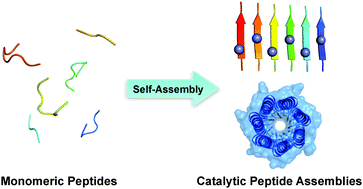Chemical Society Reviews
2018-03-29
Catalytic peptide assemblies
O. Zozulia, M. A. Dolan, I. V. Korendovych
Index: 10.1039/C8CS00080H
Full Text: HTML
Abstract

Self-assembly of molecules often results in new emerging properties. Even very short peptides can self-assemble into structures with a variety of physical and structural characteristics. Remarkably, many peptide assemblies show high catalytic activity in model reactions reaching efficiencies comparable to those found in natural enzymes by weight. In this review, we discuss different strategies used to rationally develop self-assembled peptide catalysts with natural and unnatural backbones as well as with metal-containing cofactors.
Latest Articles:
More...
|
Structure-based design of targeted covalent inhibitors
2018-04-05 [10.1039/C7CS00220C] |
|
Recent advances in radical-based C–N bond formation via phot...
2018-04-05 [10.1039/C7CS00572E] |
|
Correction: Spotting the differences in two-dimensional mate...
2018-04-04 [10.1039/C8CS90042F] |
|
Wearable and flexible electronics for continuous molecular m...
2018-04-03 [10.1039/C7CS00730B] |
|
Multimetallic nanosheets: synthesis and applications in fuel...
2018-04-03 [10.1039/C8CS00113H] |